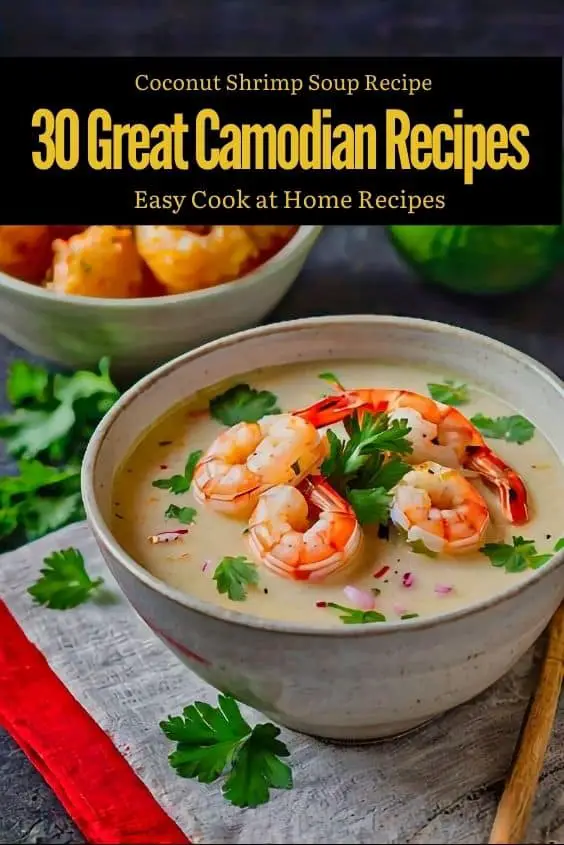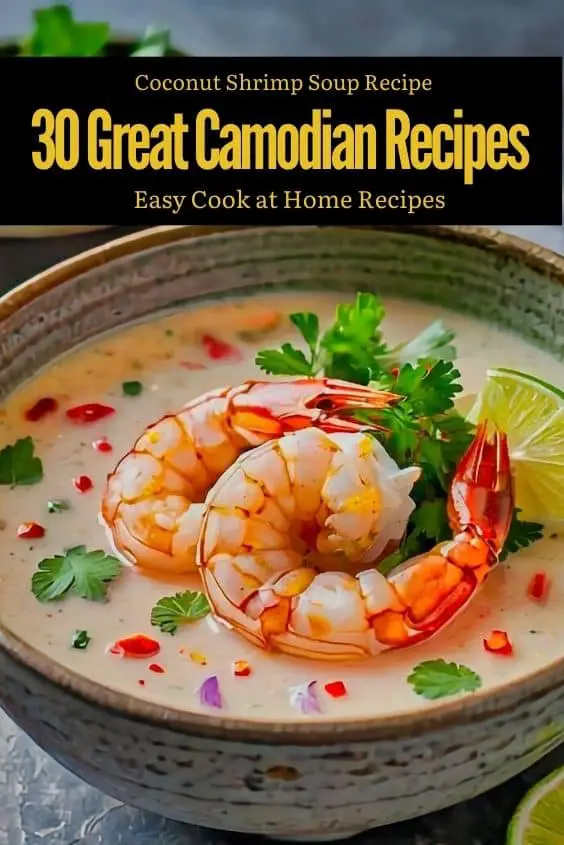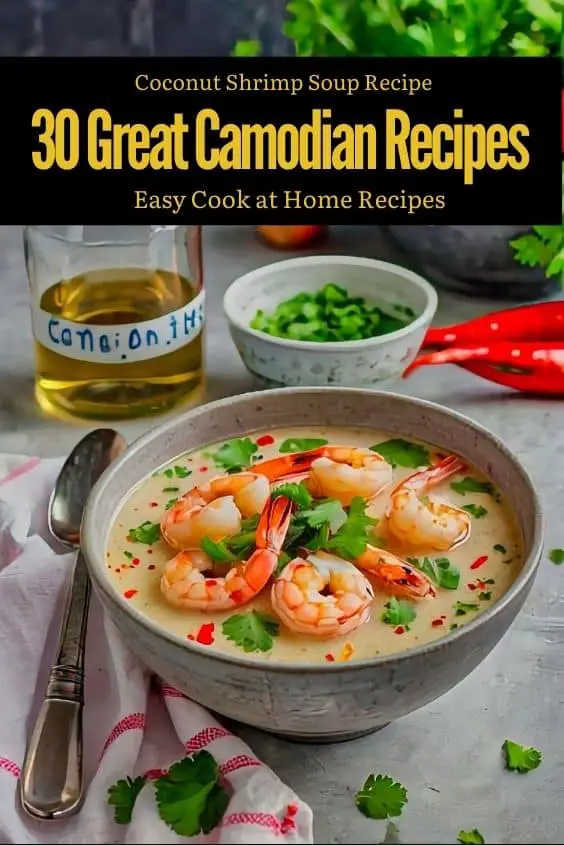Cambodian Coconut Shrimp Soup is a dish that immediately grabs attention with its appealing presentation. The soup has a light, creamy consistency with a pale, coconut-milk base that gives it a smooth and inviting appearance. Cambodian Coconut Shrimp Soup is typically served with visible pieces of shrimp floating in the broth, which are often pink and slightly curled, contrasting with the white, opaque liquid. The soup may also contain slices of vegetables like bell peppers and mushrooms, which add a touch of colour and texture.
The texture of Cambodian Coconut Shrimp Soup is notably smooth and velvety, primarily due to the coconut milk that forms the base. The soup is neither too thick nor too thin, striking a balance that allows the flavours to blend well. The shrimp in Cambodian Coconut Shrimp Soup are tender and succulent, cooked just enough to remain moist without becoming rubbery. They provide a satisfying bite that complements the creamy broth. Any additional vegetables in the soup are typically cooked until tender, contributing a slight crunch or softness depending on the type used.
In terms of makeup, Cambodian Coconut Shrimp Soup is characterised by its creamy coconut milk base, which is flavoured with a blend of spices that enhance the overall taste. The soup is often seasoned with ingredients like lemongrass or ginger, though these are integrated in a way that doesn’t overpower the dish. Cambodian Coconut Shrimp Soup is usually garnished with fresh herbs or lime wedges, but the core elements remain the shrimp and the smooth, rich broth.
Overall, Cambodian Coconut Shrimp Soup offers a visually appealing and texturally satisfying experience. The combination of tender shrimp and creamy coconut milk creates a balanced dish that is both soothing and flavourful. The soup’s appearance and texture make it a straightforward yet enjoyable meal that highlights its core components effectively.

Ingredients For the Cambodian Coconut Shrimp Soup Recipe
Shrimp
Coconut milk
Lemongrass
Kaffir Lime Leaves
Red Curry Paste
Fish Sauce
Sugar
Turmeric powder
Salt
Oil
Red Bell Pepper
Green Bell Pepper
Steamed Rice
Cooking Instructions For the Cambodian Coconut Shrimp Soup Recipe
- Heat the oil in a big saucepan over medium heat. After around two minutes of cooking, add the red curry paste, turmeric powder, kaffir lime leaves, lemongrass, and simmer until aromatic.
- Bring the sugar, fish sauce, coconut milk, and onion to a boil in a saucepan. Simmer, covered, for 10 minutes on low heat.
- Simmer the red and green bell peppers and shrimp for another 5 to 7 minutes, or until the shrimp are opaque and the sauce has reduced by half.
- Steamed rice is the perfect accompaniment for the Cambodian Coconut Shrimp Soup.
Essiential Ingredients for Cooking Cambodian Food at Home
To truly embrace the essence of Cambodian cuisine at home, it’s important to understand the essential ingredients that form the backbone of this vibrant cooking tradition. Cambodian dishes are all about balance — combining salty, sweet, sour, and bitter flavors in harmony. Below are the key ingredients that make this balance possible, along with how they are used in some traditional recipes.
One of the cornerstones of Cambodian cooking is fish sauce, a pungent yet indispensable condiment that adds saltiness and depth to a variety of dishes. Used much like salt in Western cooking, fish sauce enhances the flavors of soups, stir-fries, and marinades. In Samlor Machu Kroeung (a traditional sour soup), fish sauce is stirred into the broth to provide a rich, savory undertone that balances the sourness of tamarind. Fish sauce also makes its way into dipping sauces, commonly served alongside grilled meats.
Equally important in Cambodian cuisine is palm sugar, a natural sweetener that tempers the saltiness and acidity in many dishes. Extracted from sugar palm trees, this ingredient is used to balance bold flavors. For example, in Amok Trey, a steamed fish curry, palm sugar is mixed with coconut milk, fish sauce, and Kroeung (a Cambodian spice paste) to create a rich, well-rounded flavor profile that melds sweetness with a creamy base. Palm sugar is also essential in desserts like Num Plae Ai, sweet sticky rice balls stuffed with coconut and palm sugar filling.
Lemongrass is a fresh, citrusy herb that gives Cambodian food its distinct brightness. Typically bruised or finely chopped, lemongrass is a key component of Kroeung, a spice paste used in many soups and curries, like Samlor Korko. The herb’s aromatic oils are released when pounded, adding a zesty freshness that balances the heavier flavors of fish sauce and fermented pastes.
In addition to lemongrass, galangal plays a major role in creating Cambodian spice pastes. Although it resembles ginger, galangal has a more peppery, intense flavor that adds depth to dishes. Sliced or grated, it’s commonly used in curries like Samlor Kari (Cambodian red curry), where its sharp, earthy flavor balances out the richness of coconut milk.
Perhaps one of the most unique Cambodian ingredients is prahok, a fermented fish paste that is both divisive and essential. It has a strong, salty flavor and is often used sparingly to avoid overpowering dishes. Prahok is key in Prahok Ktis, a popular dish made by frying the paste with minced pork, coconut milk, and lemongrass, creating a savory, creamy dish that pairs well with fresh vegetables and rice.
Kaffir lime leaves are another aromatic that imparts a citrusy, fragrant note to Cambodian food. These leaves are typically torn or crushed and added to soups, stews, and curries, providing a bright, slightly floral flavor. In dishes like Samlor Machu Yuon (a Vietnamese-style sour soup), the kaffir lime leaves elevate the broth with their distinct aroma.
To create the sour component found in many Cambodian dishes, tamarind paste is often used. Tamarind adds a tangy flavor to soups, sauces, and even dipping condiments. For instance, in Samlor Machu Kroeung, tamarind is combined with lemongrass, prahok, and galangal to give the soup its signature sourness, balanced by the salty fish sauce.
Cambodian food is also known for its vibrant yellow hue in certain curries, thanks to turmeric. Fresh or powdered turmeric lends an earthy, slightly bitter flavor and a bright color to dishes like Amok Trey. The spice is often used in combination with lemongrass and galangal to create a robust curry paste.
Dried shrimp is another common ingredient that adds a concentrated, salty flavor to Cambodian salads, soups, and sauces. Ground or rehydrated, it is used in dishes like Bok L’hong (green papaya salad), where it enhances the dish with its umami notes, complementing the fresh vegetables and tangy dressing.
Finally, coconut milk is essential in many Cambodian curries and soups. Its rich, creamy texture tempers the heat from chili and the tang from tamarind, creating a smooth, luxurious base for dishes like Samlor Kari and Amok Trey. Coconut milk also plays a role in desserts, offering a sweet, creamy balance to ingredients like palm sugar and sticky rice.
These ingredients form the foundation of Cambodian cooking and are key to recreating its unique flavors at home. Whether you’re preparing a rich curry, a tangy soup, or a savory stir-fry, having these essentials on hand will help you achieve the complex, balanced taste that defines Cambodian cuisine.
Best method for cooking Cambodian rice dishes at home?
The best method for cooking Cambodian rice dishes at home involves understanding the type of rice typically used and the traditional techniques that bring out its flavors. Cambodian cuisine commonly features fragrant, long-grain jasmine rice, which is prized for its soft texture and slightly sticky quality when cooked.
Start by rinsing the rice thoroughly under cold water to remove excess starch, which can make the rice too sticky. Use a 1:1.5 rice-to-water ratio to get the perfect texture. For example, for every cup of rice, add 1.5 cups of water. Bring the water and rice to a boil in a heavy-bottomed pot, then reduce the heat to low, cover the pot, and simmer for about 15-18 minutes.
To enhance the flavor, Cambodian home cooks sometimes add pandan leaves or a pinch of salt while cooking the rice. Another popular technique is using a rice cooker, which simplifies the process by automatically adjusting the heat and cooking time for perfect results every time.
For more traditional Cambodian rice dishes like Bai Sach Chrouk (pork with rice) or Amok Trey (steamed fish curry), the rice serves as the perfect base, soaking up all the savory sauces and seasonings. Simple and versatile, properly cooked rice is a staple for any Cambodian meal.
10 Essential Ingredients to Have on Hand for Cooking Cambodian Food at Home
1. Fish Sauce – A fundamental ingredient in Cambodian cooking, fish sauce provides a salty, savory flavor. It’s commonly used in soups, stir-fries, marinades, and dipping sauces to enhance the overall taste of the dish.
2. Palm Sugar – This natural sugar is widely used in Cambodian cuisine for its rich, caramel-like sweetness. It’s key in balancing flavors in curries, sauces, and desserts, complementing the salty and tangy elements.
3. Lemongrass – Lemongrass is used for its bright, citrusy aroma and flavor. It’s typically bruised or chopped finely for use in soups, curries, and grilled dishes, adding a fresh, zesty note.
4. Galangal – Similar to ginger, galangal has a sharper, more peppery taste. It is often sliced or pounded and used in soups, stews, and curry pastes to give a distinct earthy flavor.
5. Prahok (Fermented Fish Paste) – Prahok is a potent, umami-rich paste made from fermented fish, used as a seasoning in soups, stews, and stir-fries. Its bold flavor defines many Cambodian dishes, adding depth and saltiness.
6. Kaffir Lime Leaves – These leaves are fragrant and citrusy, often torn or crushed and added to soups, curries, and stir-fries. They infuse a refreshing aroma and bright flavor into dishes.
7. Tamarind Paste – Tamarind adds a distinct sour note to Cambodian food. It’s often used in soups, dipping sauces, and marinades, providing a tangy contrast to sweet or salty ingredients.
8. Turmeric – Fresh or powdered, turmeric is used for its earthy flavor and vibrant yellow color. It’s essential in Cambodian curries, giving dishes a warm, slightly bitter undertone and a striking appearance.
9. Dried Shrimp – Dried shrimp offer a concentrated salty, umami flavor. They are typically ground or rehydrated and added to salads, soups, and dipping sauces to enhance the savory taste.
10. Coconut Milk – Coconut milk is used to create a creamy base for many Cambodian soups and curries. Its rich, mild flavor helps balance spicy and tangy elements, making it a must-have for traditional dishes.
 FAQ For the Cambodian Coconut Shrimp Soup Recipe
FAQ For the Cambodian Coconut Shrimp Soup Recipe
Q: What is the Cambodian Coconut Shrimp Soup recipe?
A: The Cambodian Coconut Shrimp Soup recipe is a flavorful dish made with shrimp, coconut milk, herbs, and spices, creating a creamy and aromatic soup.
Q: What ingredients are used in the Cambodian Coconut Shrimp Soup recipe?
A: The Cambodian Coconut Shrimp Soup recipe typically includes shrimp, coconut milk, lemongrass, galangal, lime leaves, fish sauce, and fresh herbs like cilantro.
Q: How long does it take to cook the Cambodian Coconut Shrimp Soup recipe?
A: The Cambodian Coconut Shrimp Soup recipe takes about 30 to 40 minutes to prepare, including time to cook the shrimp and blend the flavors together.
Q: Can I adjust the spice level in the Cambodian Coconut Shrimp Soup recipe?
A: Yes, the spice level in the Cambodian Coconut Shrimp Soup recipe can be adjusted by adding more or less chili, depending on your taste preference.
Q: Is the Cambodian Coconut Shrimp Soup recipe suitable for special diets?
A: The Cambodian Coconut Shrimp Soup recipe can be adapted for special diets, such as dairy-free or gluten-free, by ensuring the fish sauce and other ingredients comply with dietary restrictions.

Cambodian Coconut Shrimp Soup
Equipment
- Large Saucepan
- cutting board
- Knife
Ingredients
- 2 lbs large shrimp, peeled and deveined
- 2 cups coconut milk
- 2 stalks lemongrass, bruised and chopped
- 2 kaffir lime leaves
- 2 tbsp red curry paste
- 2 tbsp fish sauce
- 1 tbsp sugar
- 2 tsp turmeric powder
- 2 tbsp oil
- 1 red bell pepper, sliced
- 1 green bell pepper, sliced
- salt, to taste
- steamed rice, for serving
Instructions
- In a large saucepan, heat the oil over medium heat. Add the red curry paste, lemongrass, kaffir lime leaves, and turmeric powder and cook until fragrant, about 2 minutes.
- Add the coconut milk, fish sauce, and sugar to the saucepan and bring to a boil. Reduce the heat and let simmer for 10 minutes.
- Add the shrimp and red and green bell peppers to the saucepan and continue to simmer for another 5-7 minutes, or until the shrimp are fully cooked and the sauce has thickened.
- Serve the Cambodian Coconut Shrimp Soup over steamed rice.



4 comments
Just love it!
Im not convinced that adding lemongrass to the Cambodian Coconut Shrimp Soup is necessary. It seems like an unnecessary step. Anyone else feel the same way?
I dont know about you guys, but Ive never tried Cambodian food before. Do you think this Coconut Shrimp Soup recipe is worth a shot? Im curious to experiment with new flavors!
I never knew Cambodian cuisine could be so easy to recreate at home! Who wouldve thought coconut shrimp soup could be this simple to make? Cant wait to try it out and impress my friends.
Comments are closed.